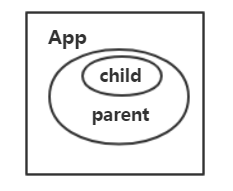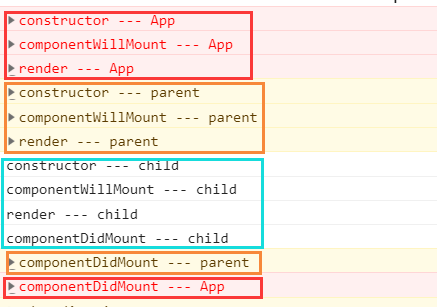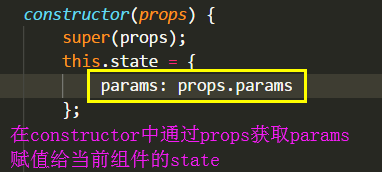有关React生命周期:
1、组件生命周期的执行次数是什么样子的???
只执行一次: constructor、componentWillMount、componentDidMount
执行多次:render 、子组件的componentWillReceiveProps、componentWillUpdate、componentDidUpdate
有条件的执行:componentWillUnmount(页面离开,组件销毁时)
不执行的:根组件(ReactDOM.render在DOM上的组件)的componentWillReceiveProps(因为压根没有父组件给传递props)
2、组件的生命周期执行顺序是什么样子的???
假设组件嵌套关系是 App里有parent组件,parent组件有child组件。

如果不涉及到setState更新,第一次渲染的顺序如下:

App: constructor --> componentWillMount --> render --> parent: constructor --> componentWillMount --> render --> child: constructor --> componentWillMount --> render --> componentDidMount (child) --> componentDidMount (parent) --> componentDidMount (App)
这时候触发App的setState事件

App: componentWillUpdate --> render --> parent: componentWillReceiveProps --> componentWillUpdate --> render --> child: componentWillReceiveProps --> componentWillUpdate --> render --> componentDidUpdate (child) --> componentDidUpdate (parent) --> componentDidUpdate (App)
那如果是触发parent的setState呢?

parent: componentWillUpdate --> render --> child: componentWillReceiveProps --> componentWillUpdate --> render --> componentDidUpdate (child) --> componentDidUpdate (parent)
那如果是只是触发了child组件自身的setState呢?

child: componentWillUpdate --> render --> componentDidUpdate (child)
结论:
1、如图:完成前的顺序是从根部到子部,完成时时从子部到根部。(类似于事件机制)
2、每个组件的红线(包括初次和更新)生命周期时一股脑执行完毕以后再执行低一级别的红线生命周期。

3、第一级别的组件setState是不能触发其父组件的生命周期更新函数,只能触发更低一级别的生命周期更新函数。
总结起来就如下图:

提问:那么这里提一个问题,如果App里面有多个parent1 parent2 ...,parent里由多个child,那么生命周期执行顺序应该时什么样的????
结论:一套组件(父包括子,子包括孙)执行的时候一个整体,执行完毕在执行下一套,用到这里就是App里先执行parent1和parent1的子,子的子。。。,然后完毕再执行parent2这一套。
3、什么时候该用componentWillReceiveProps?
是否每个子组件都需要componentWillReceiveProps生命周期函数来更新数据吗? 你的原则是??
A、开始前首先需要知道componentWillReceiveProps函数有一个参数nextProps,它是一个 { 对象 } ,从单词就可以看出它是update时候(也就是下一次)父组件传递过来的props。
B、还要知道 "第一条中" 所讲解的有些生命周期函数只执行一次,而有的执行多次,其中componentWillReceiveProps执行多次,而constructor等执行一次。
C、还需知道在子组件中每次传递过来的this.props对象其实和componentWillReceiveProps的nextProps是一样的,都是最新的。
D、由"第一条"得知: componentWillReceiveProps生命周期是在更新子组件最先执行的,优先于compoentWillUpdate,更优先于render。
E、render函数里不能使用setState(),否则会造成死循环。
那么知道了以上呢?
由C得知, this.props 和 componentWillReceiveProps的nextProps都是一样的,通过this.props就可以取到最新的值, 那么componentWillReceiveProps还有必要吗?
所以:大部分情况下 componentWillReceiveProps 生命周期函数是没用的,即可以略去不写,因为它确实没什么用。
但是情况1:
由D得知,componentWillReceiveProps是最先执行的,所以在其内可以setState({}),在接下来的render中能拿到最新的state后值,再加上B得知,
如果是下面这种情况: 在constructor函数中初始化了某个state,必须用 componentWillReceiveProps 来更新state,以便render中为新的state值。


情况2:
如果父组件有一些请求,每次参数更新的时候才发请求,同时和子组件的关系比较密切,
可以将数据请求放在componentWillReceiveProps进行执行,需要传的参数则从(nextProps)中获取。
而不必将所有的请求都放在父组件中,于是该请求只会在该组件渲染时才会发出,从而减轻请求负担。
情况3:
watch监听props值变化,对子组件进行处理,比如:当传入的props.value发生变化,执行一些动作。
如果你接触过vue,会知道vue中有一个关于watch的选项,是根据setter获取新旧值,进行动作的执行
而react中最合适做watch的时机是在componentWillReceiveProps中
componentWillReceiveProps(nextProps) { // this.props中的值是旧值 // nextProps中的值是新值 const { value: oldValue } = this.props; const { value: newValue } = nextProps; if (newValue !== oldValue) { // TODO... } }
结论: 大部分情况下 componentWillReceiveProps 生命周期函数是没用的,即可以略去不写,
但是在constructor函数中初始化了某个state,必须用 componentWillReceiveProps 来更新state,不可省去,否则render中的state将得不到更新。
同时如果您想在子组件监听watch值变化做处理,也可以用到componentWillReceiveProps
注意:使用componentWillReceiveProps的时候,不要去向上分发,调用父组件的相关setState方法,否则会成为死循环。